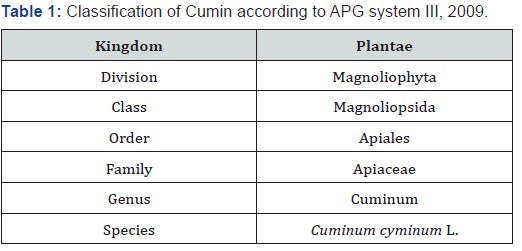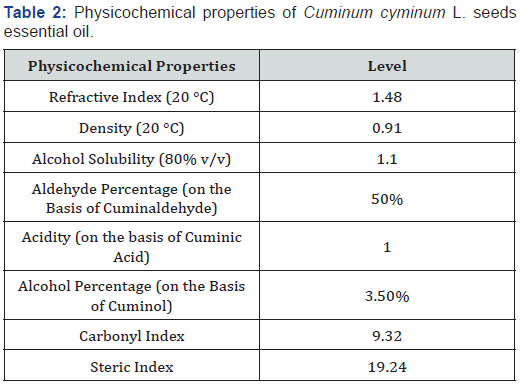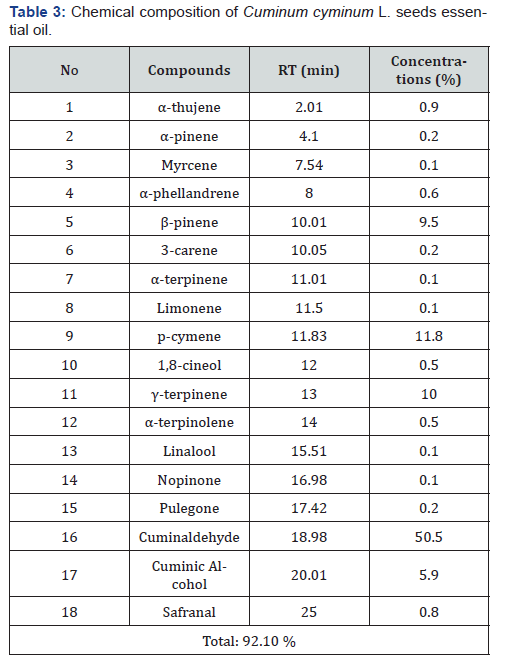Characterization of Aroma Active Compounds of Cumin (Cuminum cyminum L.) Seed Essential Oil
Hicham Boughendjioua*
Department of Natural Sciences, High School Professors Technological Education, Algeria
Submission: January 24, 2019; Published: February 28, 2019
*Corresponding author: Hicham Boughendjioua, Department of Natural Sciences, High School Professors Technological Education, Skikda, 21000, Algeria
How to cite this article: Hicham Boughendjioua. Characterization of Aroma Active Compounds of Cumin (Cuminum cyminum L.) Seed Essential Oil. Mod Appl Bioequiv Availab. 2019; 4(2): 555634. DOI: 10.19080/MABB.2019.04.555634
Abstract
Cumin (Cuminum cyminum L.) is one such most popular spice that is used as a culinary spice for their special aromatic effect. The flavor of cumin is judged by its volatile oil content. The advantage of use of volatile oil is that it is 100 times more concentrated then the spice powder and hence is required in a very less quantity. The essential oil is responsible for the characteristic cumin odor. In present study evaluation of fragrance and flavor profile in essential oil of cumin from the Algerian market (Algeria, Northwest Africa) has been identified. The essential oil from the seeds of Cuminum cyminum L. was isolated by hydro-distillation method and the chemical composition was determined by gas chromatography-mass spectrometry. Eighteen (18) components representing (91.10%) of the essential oil were identified. β-pinene (9.5%), γ-terpinene (10.0%), p-cymene (11.8%) and Cuminaldehyde (50.5%) were the major components. The essential oil was also subjected to measurement of the physicochemical properties; refractive index (20 °C): 1.48, density (20 °C): 0.91, alcohol solubility (80% v/v): 1.1, aldehyde percentage: 50%, acidity: 1.0, alcohol percentage: 3.5%, carbonyl index: 9.32 and steric index: 19.24. These results suggested that the Cuminum cyminum L. essential oil is a potential source of active ingredients for food, pharmaceutical and cosmetic industry.
Keywords: Spices; Cumin; Cuminum cyminum L.; Essential oil; GC-MS; Physicochemical properties
Abbreviations: GC-MS: Gas Chromatography-Mass Spectroscopy; MSD: Mass Selective Detector; ISO: International Organization for Standardization; French AFNOR: French Association of Normalization
Introduction
Since earliest times medicinal plants have played a vital role in the development and comfort of human civilization. Many of the plants have medicinal properties that reduce symptoms or prevent diseases [1]. Spices are widely used in the Mediterranean countries of North Africa and Southern Europe. They are also used for their flavors and aromas and for the sensations they produce. They can also be used as food colorants and antioxidants [2].
Originally from the Mediterranean area [3], Cuminum cyminum L. is an annual herbaceous plant which grows up to 15-50cm height somewhat angular and tends to droop under its own weight. It has a long, white root. The leaves are 5-10cm long, pinnate or bi pinnate, with thread-like leaflets and blue green in color and are finely divided, generally turned back at the ends. The leaves are highly dissected. Whitish-red flowers are on a compound umbel (arrangement of flowers looks like an umbrella). The fruit is an elongated, oval shaped schizocarp (an aggregate fruiting body which doesn’t break open naturally and has two single seeded units called mericarps). The fruits are similar to fennel seeds, when chewed has bitter and pungent taste. The fruit are thicker in the middle, compressed laterally about 5 inch-long, containing a single seed [4].
Although the seeds of cumin (Cuminum cyminum L.) are widely used as a spice for their distinctive aroma, they are also commonly used in traditional medicine to treat a variety of diseases. The literature presents ample evidence for the biomedical activities of cumin, which have generally been ascribed to its bioactive constituents such as terpenes, phenols, and flavonoids. Multiple studies made in the last decades validate its health beneficial effects particularly in diabetes, dyslipidemia, hypertension, respiratory disorders, inflammatory diseases, and cancer. Cumin seeds are nutritionally rich; they provide high amounts of fat (especially monounsaturated fat), protein, and dietary fiber. Vitamins B and E and several dietary minerals, especially iron, are also considerable in cumin seeds [5].
The Cumin oil is reported as a high antioxidant mainly due to the presence of monoterpene alcohols [6]. The presence of phytoestrogens in Cumin has been reported which related to its anti-osteoporotic effects. Methanol extract of Cumin showed a significant reduction in urinary calcium excretion and augmentation of calcium content and mechanical strength of bones in animals [7]. Furthermore, the aqueous extract of Cumin seeds indicated the protective effect against gentamycin-induced nephrotoxicity, which decreased the gentamycin-induced elevated levels of serum urea and enhanced the clearance of the drug [8].
Essential oils have become in recent years a matter of considerable economic importance, with a constantly growing market whose fields of application are directly related to human consumption. This is why essential oils are more and more controlled in order to verify the presence of certain toxic natural compounds, their natural origin or not, their source and the presence of certain compounds. active ingredients. The purpose of this study is to provide experimental data on the chemical composition and the physicochemical properties of cumin that could be considered suitable for application in foods and drugs.
Materials
Plant material and essential oil extraction
The seeds of the plant were used; the plant material was hydro- distilled for 90min using a Clevenger-type apparatus. (The extraction performed after a 4-hours maceration in 500ml of water). The essential oil obtained was then dehydrated over anhydrous sodium sulphate and stored in a refrigerator at 4 °C until use. The plant was identified by Dr. Hicham Boughendjioua at the Department of Natural Sciences, High School Professors Technological Education, Skikda (Algeria). The voucher specimen under the plant’s name deposited then in the herbarium.
GC-MS analysis
Gas chromatography-mass spectroscopy (GC-MS) analyses of essential oil samples were carried out on a Hewlett-Packard 6890N gas chromatograph coupled to a HP 5973 mass selective detector (MSD). A HP5 column (30m х 0.32mm film thickness 0.25μm) was used. The analysis was performed using the following temperature program: oven isotherm at 35 °C for 5 min then from 35 to 250 °C at 6 ºC/min. Helium was used as the carrier gas at 1ml/min flow rate. The injector and detector temperatures were held, respectively, at 250 ºC. Mass spectra were recorded with ionization energy of 70eV and interface temperature of 280 °C. The identification of the oil constituents was based on a comparison of their retention indices relative. Further identification was made by matching their recorded mass spectra with those stored in the NIST mass spectral library of the GC-MS data system.
Results and Discussion
Classification of cumin
The plant was classified according to APG system III, 2009 (Table 1) [9].

Essential oil yield
The extracted cumin essential oil has dark yellow color, with an odor hot, powerful and spicy. The percentage yield of essential oil was calculated as per Moawad et al. [10], it is calculated on the weight basis. The equation is as follows: Volatile oil (%) = (Weight of the volatile essential oil recovered in g x 100)/Weight of sample taken in g. Yield estimation studies indicate that the value of essential oil was: 3.66%.
Physicochemical properties
Essential oils must meet characteristics imposed by the laws of producing and exporting countries and by importing countries. These criteria are defined in international standards ISO (International Organization for Standardization) or French AFNOR (French Association of Normalization). Thus, the organoleptic and physical properties such as coloration, odor, refraction, solubility, flash point, but also chemical properties such as acid and ester indices are controlled [11]. Physicochemical properties of the essential oil obtained by hydro-distillation from Cumin seeds are summarized in Table 2.

Chemical composition
Due to the enormous amount of raw product used to make wholly natural essential oils, it is important to study the chemical composition of the volatile fraction once the essential oil is extracted. Essential oils are hydrophobic and concentrated liquids whose composition is complex. The best qualitative and quantitative identity card of an essential oil, however, remains its chromatographic profile, most of which is carried out in gas chromatography.
The chemical compositions of Cuminum cyminum L. essential oil are shown in Table 3, Figure 1. Eighteen (18) components representing 91.10% of the essential oil were identified. β-pinene (9.5%), γ-terpinene (10.0%), p-cymene (11.8%) and Cuminaldehyde (50.5%) were the major components.


The essential oil of the seeds of Cuminum cyminum L. from China was isolated by hydrodistillation in a yield of 3.8%. The chemical composition of the essential oil was examined by GC and GC-MS; 37 components, representing 97.97% of the oil, were identified. Cuminal (36.31%), cuminic alcohol (16.92%), γ-terpinene (11.14%), safranal (10.87%), p-cymene (9.85%) and β-pinene (7.75%) were the major components [12].
The main constituents at different harvesting time being cumin aldehyde (19.9-23.6%), p-mentha-1,3-dien-7-al (11.4-17.5%) and p-mentha-1,4-dien-7-al (13.9-16.9%). The results of GC and GC/MS analysis showed that the fruits should be harvested at the ripe stage for ideal volatile oil yield and composition [13].
GC and GC-MS analyses of the essential oil of Cuminum cyminum L. from the Alborz Mountain range of Iran revealed contained α-pinene (29.2%), limonene (21.7%), 1,8-cineole (18.1%), linalool (10.5%), and α-terpineole (3.17%) as the major compounds [14].
Cuminum cyminum L. seeds essential oil was isolated by hydrodistillation method and the chemical composition was determined by gas chromatography-mass spectrometry (GC/MS). The yield of the oil was found to be 3.0% (on dry weight basis). A total of twenty-six components, representing 96.7% of the oil were identified. Cuminaldehyde (49.4%), p-cymene (17.4%), β-pinene (6.3%), α-terpinen-7-al (6.8%), γ- terpinene (6.1%), p-cymen-7- ol (4.6%) and thymol (2.8%) were the major components in the oil [15].
Composition of the essential oil, which was obtained from the seeds of Cuminum cyminum L. collected from Ilam, was determined by GC-MS. In total, 25 components (83.36%) of essential oil were identified. Major constituents were Isobutyl isobutyrate (0.45%), α-thujene (0.5%), α-pinene (30.12%), sabinene (1.11%), myrcene (0.34%), γ-3-carene (0.21%), p-cymene (0.6%), limonene (10.11%), 1,8-cineole (11.54%), (E)-ocimene (0.1%), γ-terpinene (3.56%), terpinolene (0.32%), linalool (10.3%), α-campholenal (1.76%), terpinene-4-ol (0.6%), trans-carveole (0.7%), geraniol (1.0%), linalyl acetate (4.76%), α-terpinyl acetate (1.8%), neryl acetate (1%), methyl eugenol (0.2%), β-caryophyllene (0.42%), α-humulene (0.3%), spathulenol (0.56%) and humulene epoxide II (1%) [16].
The essential oil content in cumin samples from Serbian market ranged between 2.0 and 4.0%, with 22 identified compounds, among which the most abundant were cumin aldehyde, β-pinene, γ-terpinene, γ-terpinene-7 al and p-cymene. Post-distillation cumin seeds waste material that remained after the essential oil extraction contains total polyphenols of between 30.1 and 47.5 mg GAE/g dry extract, as estimated by the Folin Ciocalteu method. Hydroxybenzoic and hydroxycinnamic acids, as well as glycosides of flavonones and flavonoles, are the dominant polyphenols [17].
The major constituents of the essential oil from the cumin fruits under different conditions of storage were cumin aldehyde belonging to oxygenated monoterpenes and p-cymene, and β-pinene belonging to monoterpene hydrocarbons. Results indicated that at room temperature, the proportions of compounds with lower boiling temperatures such as β-pinene (1.57-10.03%) and p-cymene (14.93-24.9%) were decreased; however, cumin aldehyde (45.45-64.31%) increased during cumin oil storage [18].
The GC-MS analysis of cumin oil showed that eleven constituents were identified; seven hydrocarbon monoterpens (33.09%) and four oxygenated monoterpens (66.92%). The monoterpens were α-thujene (0.41%), α-pinene (0.90%), β-pinene (10.72%), β-myrcene (1.27%), α-phellandrene (1.18%), p-cymene (3.54%) and γ-terpinene (15.07%), and oxygenated monoterpens identified were cumin aldehyde (21.10%), carboxaldehyde (5.34%), 2-caren-10-al (17.74%) and cumin alcohol (22.65%) [19].
This deviation from the common chemo-types may be attributed to the effect of the factors that specifically affect the composition and yield of the essential oil, which include seasonal and maturity variation, geographical origin, genetic variation, growth stages, postharvest drying and storage [20-23].
Conclusion
Cumin (Cuminum cyminum L.) is the second most popular spice in the world, after black pepper, and used as a medicinal plant for aromatherapy and various illnesses. Determination of the physicochemical characteristics of the oil may establish by measurement of extraction yield, refractive index, density, carbonyl and steric indexes together with aldehyde, alcohol and acid contents.
In the chemical profiling, eighteen (18) components representing (91.10%) of the essential oil were identified, of which Cuminaldehyde with a concentration of (50.5%) was the main constituent, the physicochemical properties of the essential oil were also subjected to study (measurement).
Essential oils have become in recent years a matter of considerable economic importance, with a constantly growing market whose fields of application are directly related to human consumption. This is why essential oils are more and more controlled in order to verify the presence of certain natural toxic compounds, their natural or non-natural origin, their source and the presence of certain active compounds and even though the plant biomass a very promising source for the future, very little works has been done on the study of the organoleptic and physicochemical properties of aromatic fractions of cumin. Due to its chromatographic profile, the essential oil extracted by hydrodistillation of this plant has organoleptic and physicochemical properties very appreciated in perfumery and will be very coveted in the sector of the food, pharmaceutical and cosmetic industry.
References
- Lai PK, Rov J (2004) Antimicrobial and chemopreventive properties of herbs and spices. Curr Med Chem 11(11): 1451-1460.
- Amechrouq A, Elhourri M, Ghouati Y, Chakir S, Lemrhari A (2018) Comparative study of the chemical composition of essential oils of Cuminum cyminum seeds of the Mediterranean. Green and Applied Chemistry 3(3): 47-57.
- (2019) Cumin essential oil information.
- Gohari AR, Saeidnia S (2011) A Review on Phytochemistry of Cuminum cyminum seeds and its Standards from Field to Market. Pharmacognosy Journal 3(25): 1-5.
- Srinivasan k (2018) Cumin (Cuminum cyminum) and black cumin (Nigella sativa) seeds: traditional uses, chemical constituents, and nutraceutical effects. Food Quality and Safety 2(1): 1-16.
- De Martino L, De Feo V, Fratianni F, Nazzaro F (2009) Chemistry, antioxidant, antibacterial and antifungal activities of volatile oils and their components. Nat Prod Commun 4(12): 1741-1750.
- Shirke SS, Jadhav SR, Jagtap AG (2008) Methanolic extract of Cuminum cyminum inhibits ovariectomy-induced bone loss in rats. Exp Biol Med (Maywood) 233(11): 1403-1410.
- Mahesh CM, Gowda KPS, Gupta AK (2010) Protective action of Cuminum cyminum against gentamicin- induced nephrotoxicity. Journal of Pharmacy Research 3(4): 753-757.
- APG III (2009) An update of the Angiosperm phylogeny group classification for the orders and families of flowering plants. Botanical Journal of the Linnean Society 161(2): 105-121.
- Moawad SA, El-Ghorab AH, Hassan M, Nour-Eldin H, El-Gharabli MM (2015) Chemical and Microbiological Characterization of Egyptian Cultivars for Some Spices and Herbs Commonly Exported Abroad. Food and Nutrition Sciences 6(7): 643-659.
- Boughendjioua H, Djeddi S (2018) Study of The Organoleptic and Physicochemical Properties of Cinnamon Essential Oil (Cinnamomum zeylanicum). American Journal of Life Science Researches 6(3): 123-130.
- Kan Y, Kartal M, Ozek T, Erdem SA (2007) Composition of essential oil of Cuminum cyminum according to harvesting times. European Journal of Pharmaceutical Sciences 4(1): 25-29.
- Rong Li, Zi-Tao Jiang (2004) Chemical composition of the essential oil of Cuminum cyminum from China. Flavour and Fragrance Journal 19(4): 311-313.
- Mohammadpour H, Moghimipour E, Rasooli I, Fakoor MH, Astaneh SA, et al. (2012) Chemical Composition and Antifungal Activity of Cuminum cyminum Essential Oil from Alborz Mountain Against Aspergillus species. Jundishapur J Nat Pharm Prod 7(2): 50-55.
- Virendra S Rana (2014) Chemical Composition of the Essential Oil of Cuminum cyminum Seeds from Western India. Journal of Medicinal Plants and By-products 2: 207-210.
- Esmaeili F (2015) Composition of Essential Oil of Cuminum cyminum. Journal of Essential Oil-Bearing Plants 18(2): 507-509.
- Aćimović MG, Tešević V, Mara D, Cvetković M, Stanković J, et al. (2016) The analysis of cumin seeds essential oil and total polyphenols from post-destillation waste material. Advanced technologies 5(1): 23-30.
- Mehdizadeh L, Pirbalouti AG, Moghaddam M (2017) Storage stability of essential oil of cumin (Cuminum cyminum) as a function of temperature. International Journal of Food Properties 20(2): 1742-1750,
- Belal AA, Ahmed FBM (2017) Effect of Cuminum cyminum Oil on the Chemical Properties of Sunflower Reused Oil. Journal of Food and Nutrition Sciences 5(4): 162-166.
- Marotti M, Piccaglia R, Giovanelli E (1994) Effects of variety and ontogenic stage on the essential oil composition and biological activity of fennel (Foeniculum vulgare). Journal of Essential Oil Research 6(1): 57-62.
- Hussain AI, Anwar F, Sherazi ST, Przybylski R (2008) Chemical composition, Antioxidant and antimicrobial activities of basil (Ocimum basilicum) essential oils depends on seasonal variations. Food Chem 108(3): 986-995.
- Butkiene R, Sakociute V, Latvenaite D, Mockute D (2008) Composition of youngand aged shoot essential oils of the wild Ledum palustre (L.). Chemija 19(2): 19-24.
- Verma RS, Verma RK, Chauhan A, Yadav AK (2009) Changes in the essential oil content and composition of Eucalyptus citriodora Hook during leaf ontogeny and leaf storage. Indian Perfumer 53: 22-25.






























